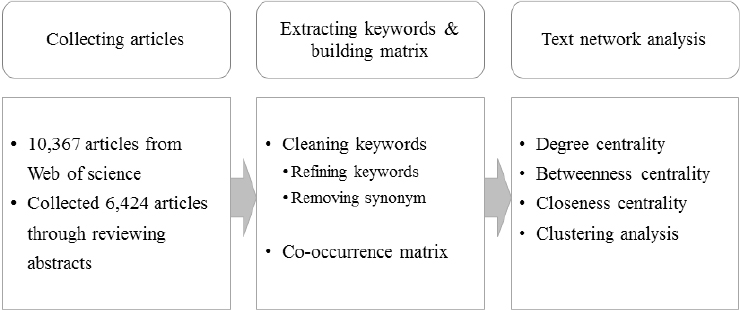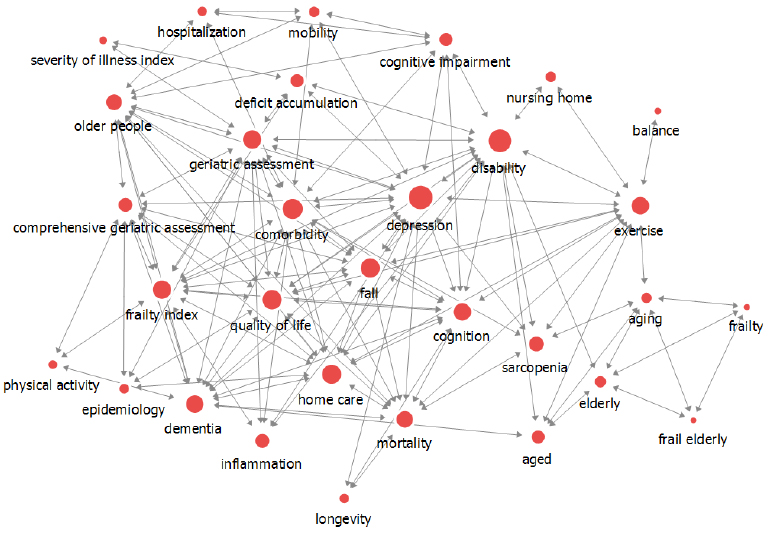J Korean Acad Community Health Nurs.
2018 Dec;29(4):429-439. 10.12799/jkachn.2018.29.4.429.
Co-occurrence Network Analysis of Keywords in Geriatric Frailty
- Affiliations
-
- 1Assistant Professor, College of Nursing, Gachon University, Incheon, Korea.
- 2Professor, Red Cross College of Nursing, Chung-Ang University, Seoul, Korea.
- 3Assistant Professor, Department of Nursing, Woosong University, Daejeon, Korea. jlim0202@hanmail.net
- KMID: 2430177
- DOI: http://doi.org/10.12799/jkachn.2018.29.4.429
Abstract
- PURPOSE
The aim of this study is to identify core keyword of frailty research in the past 35 years to understand the structure of knowledge of frailty.
METHODS
10,367 frailty articles published between 1981 and April 2016 were retrieved from Web of Science. Keywords from these articles were extracted using Bibexcel and social network analysis was conducted with the occurrence network using NetMiner program.
RESULTS
The top five keywords with a high frequency of occurrence include "˜disability', "˜nursing home', "˜sarcopenia', "˜exercise', and "˜dementia'. Keywords were classified by subheadings of MeSH and the majority of them were included under the healthcare and physical dimensions. The degree centralities of the keywords were arranged in the order of "˜long term care' (0.55), "˜gait' (0.42), "˜physical activity' (0.42), "˜quality of life' (0.42), and "˜physical performance' (0.38). The betweenness centralities of the keywords were listed in the order of depression' (0.32), "˜quality of life' (0.28), "˜home care' (0.28), "˜geriatric assessment' (0.28), and "˜fall' (0.27). The cluster analysis shows that the frailty research field is divided into seven clusters: aging, sarcopenia, inflammation, mortality, frailty index, older people, and physical activity.
CONCLUSION
After reviewing previous research in the 35 years, it has been found that only physical frailty and frailty related to medicine have been emphasized. Further research in psychological, cognitive, social, and environmental frailty is needed to understand frailty in a multifaceted and integrative manner.
Keyword
MeSH Terms
Figure
Reference
-
1. Korean Statistical Information Service. Projected population by age group [Internet]. Seoul: Statistics Korea;cited 2018 April 09. Available from: http://kosis.kr/statHtml/statHtml.do?orgId=101&tblId=DT_1BPA002&vw_cd=MT_TM1_TITLE&list_id=101_A0502&seqNo=&lang_mode=ko&language=kor&obj_var_id=&itm_id=&conn_path=MT_TM1_TITLE.2. Kim KH, Yoon HJ. Factors that affect the frailty of the elderly people over 70-year-old in a local community. Journal of the Korea Academia-Industrial cooperation Society. 2017; 18(2):313–323. DOI: 10.5762/KAIS.2017.18.2.313.3. Kim Y, Jang SN. The study for improvement of frailty and depression in the health vulnerable elderly of home visiting health care service. Journal of Korean Geriatric Society. 2016; 20(2):85–93. DOI: 10.4235/jkgs.2016.20.2.85.
Article4. Hogan DB. Models, definitions, and criteria for frailty. In : Ram JL, Conn PM, editors. Conn's handbook of models for human aging. 2nd ed. London: Academic press;2018. p. 35–44.5. Fried LP, Tangen CM, Walston J, Newman AB, Hirsch C, Gottdiener J, et al. Frailty in older adults: Evidence for a phenotype. The Journals of Gerontology Series A: Biological Sciences and Medical Sciences. 2001; 56(3):M146–M156. DOI: 10.1093/gerona/56.3.M146.
Article6. Whitson HE, Purser JL, Cohen HJ. Frailty thy name is... phrailty? The Journals of Gerontology Series A: Biological Sciences and Medical Sciences. 2007; 62(7):728–730. DOI: 10.1093/gerona/62.7.728.7. Clegg A, Young J, Iliffe S, Rikkert MO, Rockwood K. Frailty in elderly people. The Lancet. 2013; 381(9868):752–762. DOI: 10.1016/S0140-6736(12)62167-9.
Article8. Wilson JF. Frailty-and its dangerous effects-might be preventable. Annals of Internal Medicine. 2004; 141(6):489–492. DOI: 10.7326/0003-4819-141-6-200409210-00035.
Article9. Jeon EY, Kim KB. A study of factors that influence the promotion of health behavior in the elderly according to types of residency. Journal of Korean Academy of Nursing. 2006; 36(3):475–483. DOI: 10.4040/jkan.2006.36.3.475.10. De Roeck EE, Dury S, De Witte N, De Donder L, Bjerke M, De Deyn PP, et al. CFAI-Plus: Adding cognitive frailty as a new domain to the comprehensive frailty assessment instrument. International Journal of Geriatric Psychiatry. 2018; 33(7):941–947. DOI: 10.1002/gps.4875.
Article11. Bandeen-Roche K, Xue QL, Ferrucci L, Walston J, Guralnik JM, Chaves P, et al. Phenotype of frailty: Characterization in the women's health and aging studies. The Journals of Gerontology: Series A, Biological Sciences and Medical Sciences. 2006; 61(3):262–266. DOI: 10.1093/gerona/61.3.262.
Article12. Rolfson DB, Majumdar SR, Tsuyuki RT, Tahir A, Rockwood K. Validity and reliability of the edmonton frail scale. Age and Ageing. 2006; 35(5):526–529. DOI: 10.1093/ageing/afl041.
Article13. Lee I, Park YI, Park E, Lee SH, Jeong IS. Validation of instruments to classify the frailty of the elderly in community. Journal of Korean Academy of Community Health Nursing. 2011; 22(3):302–314. DOI: 10.12799/jkachn.2011.22.3.302.
Article14. Collard RM, Boter H, Schoevers RA, Oude Voshaar RC. Prevalence of frailty in community-dwelling older persons: A systematic review. Journal of the American Geriatrics Society. 2012; 60(8):1487–1492. DOI: 10.1111/j.1532-5415.2012.04054.x.
Article15. Kim YH. Social network analysis. 3rd ed. Seoul: Park Young Sa;2013. p. 345.16. Kim YH, Yu SY. A comparative study of comparative studies of Korea and Japan: Co-word analysis in social science and humanities. Social Science Review. 2013; 44(1):25–45.17. Lee S, Jeong S, Kim H, Yom Y. A social network analysis of research topics in Korean nursing science. Journal of Korean Academy of Nursing. 2011; 41(5):623–632. DOI: 10.4040/jkan.2011.41.5.623.
Article18. Park EJ, Kim YJ, Park CS. A comparison of hospice care research topics between Korea and other countries using text network analysis. Journal of Korean Academy of Nursing. 2017; 47(5):600–612. DOI: 10.4040/jkan.2017.47.5.600.
Article19. Zhang J, Xie J, Tu X, Xu J, Song F, Hou W, et al. Mapping the knowledge structure of research on patient adherence: Knowledge domain visualization based co-word analysis and social network analysis. PLoS ONE. 2012; 7(4):e34497. DOI: 10.1371/journal.pone.0034497.
Article20. Kim Y, Jang SN. Mapping the knowledge structure of frailty in journal articles by text network analysis. PLoS ONE. 2018; 13(4):e0196104.
Article21. Persson O, Danell R, Schneider JW. How to use bibexcel for various types of bibliometric analysis. Celebrating Scholarly Communication Studies: A Festschrift for Olle Persson at His 60th Birthday. 2009; 9–24.22. Paranyushkin D. Identifying the pathways for meaning circulation using text network analysis [Internet]. Berlin: Nodus Labs;2011. cited 2018 April 29. Available from: http://Noduslabs.Com/Research/Pathways-Meaning-Circulation-Text-Network-Analysis.23. Son DW. Social network analysis. Seoul: Koung Moon Sa;2012. p. 254.24. SunWoo D, Lee S, Park JS, Bae SS, Cho YH, Kim CB, et al. Analysis of the effects of muscle strength exercise on physical function and quality of life in the frail elderly. Korean Journal of Health Education and Promotion. 2008; 25(1):39–53.25. Cesari M, Vellas B, Hsu FC, Newman AB, Doss H, King AC, et al. A physical activity intervention to treat the frailty syndrome in older persons-Results from the LIFE-P study. The Journals of Gerontology: Series A, Biological Sciences and Medical Sciences. 2015; 70(2):216–222. DOI: 10.1093/gerona/glu099.
Article26. Lee IH, Kong JY, Jun YY, Kang HS. Associations of physical frailty with cognitive function and depression in elderly women. Journal of the Korean Society of Living Environmental System. 2017; 24(2):245–253. DOI: 10.21086/ksles.2017.04.24.2.245.
Article27. Ma L, Tang Z, Zhang L, Sun F, Li Y, Chan P. Prevalence of frailty and associated factors in the community-dwelling population of China. Journal of the American Geriatrics Society. 2018; 66(3):559–564. DOI: 10.1111/jgs.15214.
Article28. Woo J, Goggins W, Sham A, Ho SC. Social determinants of frailty. Gerontology. 2005; 51(6):402–408. DOI: 10.1159/000088705.
Article29. Brooks D, Davis AM, Naglie G. Validity of 3 physical performance measures in inpatient geriatric rehabilitation. Archives of Physical Medicine and Rehabilitation. 2006; 87(1):105–110. DOI: 10.1016/j.apmr.2005.08.109.
Article30. Shrap T, Malyon A, Barclay S. GPs' perceptions of advance care planning with frail and older people: A qualitative study. British Journal of General Practice. 2018; 68(666):e44–e53. DOI: 10.3399/bjgp17X694145.




